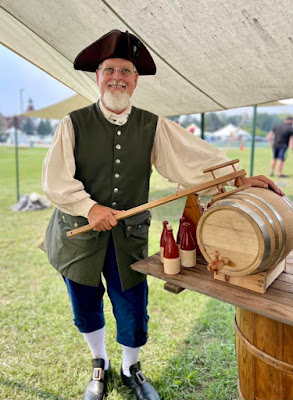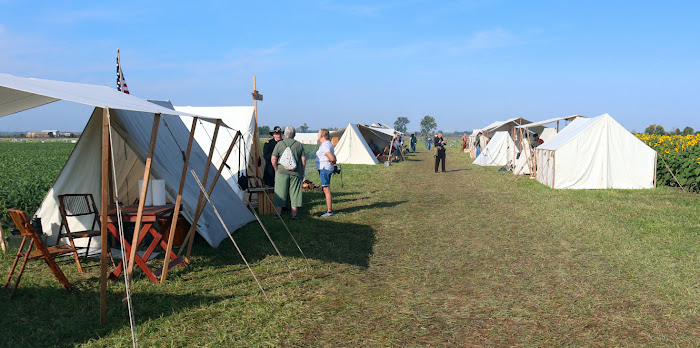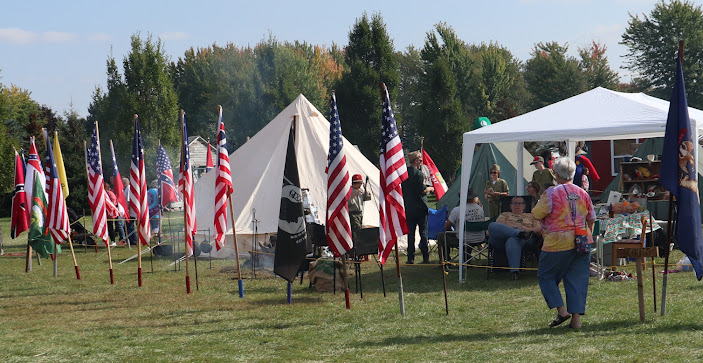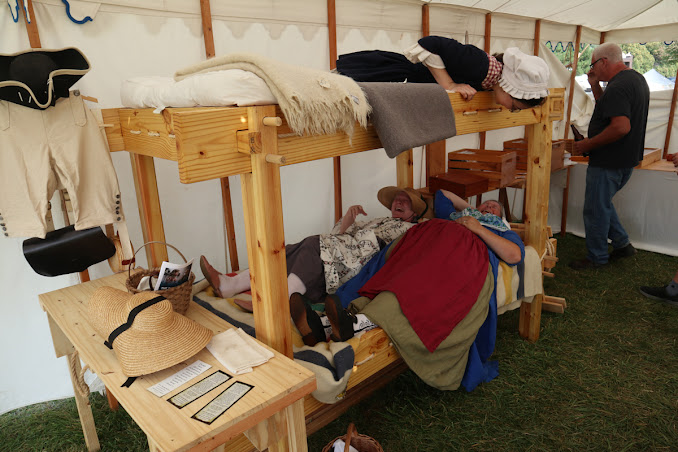 |
| Morning has broken... The first dawn of Autumn. |
So, I awakened about six of the clock in the morning of September 23. Due to the fact that this was the first dawn of Fall - and being that it was now late September, it was still dark - the sun does not begin to show at this time of the year until closer to seven. But here I was, up-and-at-'em, and excited to make the nearly two-hour trek to Saginaw, Michigan for the wonderful River of Time reenactment. However, as I was in my back room gathering up a few 1700s items to wear at the event, such as my buckle shoes and my cocked (tricorn) hat, I noticed a few apples we picked the previous Sunday a-sitting separate on our table, right in front of the crate, which was also filled with apples, and, with that, a picture popped into my head. So I lit a candle and surrounded it with the fresh-picked apples.
Yep---it was a good way to get me mentally ready to travel back in time---I, myself (along with Larissa & Jackie), would be dressed to about the year 1775.
It was going to be a great day...
~~~~~........~~~~
Michigan knows how to celebrate history.
Michigan knows how to celebrate fall.
Put the two subjects together and you have the River of Time historical timeline event. And the day we took part was the first day of autumn; the sun was out, the sky was blue, it was beautiful, the temps were, too...
Three of us who are part of the core cabin group were there at River of Time together: myself, Jackie, & Larissa, and, per normal for us, we had such fun together, with lots of laughs and good conversation.
We spent most of our time roaming the complex of Johnson's Pumpkin Farm, enjoying seeing the different eras in time.
If you are unfamiliar with fall in Michigan, we do it right and we do it up big. We celebrate the fall here by going to cider mills, pumpkin farms, and apple picking orchards, purchasing cider, doughnuts, pies, fruits, vegetables, pure maple syrup, and even traditional craft items, usually homemade and oftentimes totally unique / one-of-a-kind. Let me tell you, the cider mills are packed every weekend from Labor Day through early November - thousands of visitors and patrons visit these places each weekend; it's a wonderful tradition of which my family and I also partake. Johnson's Pumpkin Farm is one such place, only this year they have welcomed us reenactors:
"Your favorite mid-Michigan reenactment event has moved to the farm! Take a step back in time at Johnson’s. Speak with in-character reenactors to learn about the history of our country. Period music will entertain and the ever popular root beer will be flowing!"
Over the past few years I have participated in a number of timeline events, including last year's River of Time (while it was still in Bay City) as well as a more recent one in Monroe this past July; this sort of reenactment seems to be growing in popularity. But if you look at the schedule of events, even the least fan of history can find something of interest:
 |
| There is so much to see - a travel through time. |
And there, at noon on Saturday, I, as Paul Revere, was part of the schedule of events, sharing time and the stage with Ben Franklin.
I am honored.
 |
| But Ben & I did not share the stage together. We, instead, spoke of our accomplishments separately. |
Since Ben Franklin had much more to speak about, for his life is more well-known, it was decided I would go on first, as a sort of opener, so at high noon, I began my story, and I am very pleased to say I had a wonderful good-sized audience at hand to hear of my most-famous midnight ride.
This early patriot I was portraying did more than most people realize - too many still believe the myths and rumors and, in more recent times, condemnations, without taking the time to search for themselves for the truth (isn't that the way it is these days? I call them Facebook University grads lol) - and I like to believe Mr. Revere himself is happy with what I'm doing.
 |
| It is an honor for me to portray my childhood hero, Paul Revere. |
As is stated on the Paul Revere Heritage Project website, “(Longfellow) meant to retell the story taking the liberty to dramatize Revere’s individuality, patriotism and the fight for independence. Longfellow created a national icon from a local folk hero hardly known outside Massachusetts. He also dramatized Revere’s ride creating a national myth.
During (the last half) of the nineteenth century Longfellow’s poem was considered a historical account and evidence of what happened the night of April 18, 1775 and many textbooks were written based on Longfellow’s poem. During the 20th century, textbook writers and historians tried to portray a more objective account of the facts. They argued about the inaccuracies of the poet’s account and what were the real events, they tried to demythologize the poem.
Nevertheless, Longfellow's poem has become so successful and ingrained in every American mind that readers no longer remember it as a poem but as a national legend. It is a reminder of the patriotism that led to independence and a part of the American culture."
Patriotism is a wonderful thing, so I can appreciate that. Even with his human faults, however, Paul Revere, in my opinion, was a great man who did wonderful things and deservedly belongs in a good place in American History, to be sure.
To read a more concise piece on Revere that covers the truth of what happened on the night of April 18th, 1775, please click HERE.
One of the things I really got a kick out of was when people would ask to have a photograph taken with me, for it's not everyday one can meet Paul Revere.
It truly is an honor.
It was also my privilege to introduce the next speaker/presenter, Benjamin Franklin.
 |
| Bob Stark as Benjamin Franklin - yes, he even looks like him! |
Bob as Ben did not do the more conventional presentation; instead he went into the audience and asked them if they had any questions. Some asked about his inventions while others mentioned his role in the Declaration of Independence. It was a bit more personable type of presentation.
Franklin was followed by Abby Stark (who just so happens to be his daughter!), with a very interesting speech and lesson on colonial tea. Abby is new to public speaking in this manner and she did very well - she held a good audience while explaining the importance of tea in the colonies, and, of course, of the Boston Tea Party, which, in this year of 2023, is the 250th anniversary (1773).
When the presentations had ended, Larissa, Jackie, and I visited Ben Franklin's (and Abby's) Salty Lantern sutlery, where Abby sells the type of tea that was dumped over-board by the Sons of Liberty on the night of December 16, 1773!
 |
| In fact, Jackie did! A taste of history~ |
Ben/Bob is a wood worker, and he makes many period items that can work for reenactors and modern folk who have a penchant for tradition, including wooden rope bunk beds.
So, my companions, along with Abby, decided to try them out, and had a little fun in the meantime:
 |
| "Time to wake up, Wilhelmina!" |
We very much enjoyed roaming throughout the large encampment:
 |
| Revolutionary War was represented - - - here we have the 49th Regiment Of Foot~  |
And we hade some wonderful period music:
 |
| The Tittabawassee Valley Fife & Drum Corps played the familiar period music as well as field music of the Revolutionary War era. |
And then there was Larry Kula, the Colonial Brewer:
 |
| Would you like a glass full? |
 |
| Some beer a-brewin' |
From the Colonial Williamsburg site:
The introduction of hops resulted in a change in the definition of beer and ale. By the 1500s beer had become a malt beverage with hops, while ale was a malt beverage made without hops. This distinction was maintained for about 200 years. During this period fines were imposed for putting hops into ale. Soon, the preserving qualities of hops won out over the prejudice against its flavor. During the 18th-century the distinctions between beer and ale became more vague. The term ale is sometimes used to indicate a stronger drink, but this usage is not consistent.
Just a ways away we visited with the Voyageurs, most depicting life of the 18th century:
 |
| The Voyageurs always have a wonderful set up and display. |
 |
| A blacksmith was on hand... |
 |
| In the Voyageur camp~ |
 |
| In the Voyageur Camp |
 |
| I have reenacted with the Lac Ste. Claire Voyageurs, but this group are the Great Lakes Voyageurs. |
 |
| I always love it when Native Americans come out and participate. |
 |
| The Civil War was represented as well. |
 |
| A little intermingling of two different time periods: Revolutionary War era and the Civil War era. But Butch was kind enough to give each of us a slice of freshly baked carrot cake! |
 |
| More from the Civil War camps. |
I was hoping to see a few more eras in between Civil War and World War Two, but, unfortunately, no one depicting Span-Am, WWI, or even earlier, such as War of 1812 were there. And that's a shame, for here is an opportunity to teach history to thousands of people.
Well, there's always next year. And I hope we see the periods I just mention, as well as the citizens of the 1910s, 1920s, and other known decades.
Maybe even a few Rosie the Riveters!
So now we jump up to the 1940s:
At around three o'clock they had a WWII plane do a "fly over," which was very cool to see.
I was able to get a couple of nice photos:
 |
| I do not know what kind of plane this was, but the schedule said there would be a "WW2 Fly Over." |
 |
| I was able to snatch a close up! |
 |
| Richard is wearing 1940’s era French civilian clothing with a WWI French infantry military side cap.  |
 |
| Desert Storm - early 1990s. |
One particular stop we made was to visit long-time friend and long-time reenactor, Will Eichler.
For years he has put together historical snippets on his You Tube channel, Civil War Digital Digest. As is noted on the web site: "Civil War Digital Digest is your first stop for high quality videos on American Civil War era history and living history topics. Avid living historians, relaxed armchair generals, and teachers will find resources that both educate and entertain."
For more information, please check this link out:
But that's not all Mr. Eichler is delving into when it comes to promoting history:
 |
| Escape into history, by way of the present and future. |
At River of Time, Will was mainly promoting HistoryFix, which was launched on June 14, 2022, and, well, it worked, for I ended up subscribing to the channel the next day!
As is written in his flyer: "Tired of sifting through generic content on mainstream streaming platforms?
Yearning for a streaming service that caters specifically to your passion for history?
Whatever you enjoy: American Civil War, World Wars, modern history, or others - there's something for everyone to enjoy.
With History Fix you get access to an extensive and growing library of carefully curated movies, series, and documentaries - all dedicated to capturing the essence of various historical periods."
Will pointed out that, "The point is we focus on people being able to enjoy a History where they are – whether movies or documentaries. Whether online or on an app. Whether first century or 21st century."
And isn't history what this is all about?To be able to walk around and seeing all of this American History come to life right before your eyes - from Native Americans on up - is always exciting, even for those not heavily into the subject, and personally for me it was such an honor to play a part, as Paul Revere. Being stopped a few times by folks who enjoyed my presentation was an honor indeed.
But it was great hanging out with a few of my "besties" - - -
 |
| The three amigos. We had just a good time here at River of Time. I am already looking forward to next year! |
Being that this is a working farm, there were also chickens, cows, and even an emu!
 |
| Larissa met Doug the Emu! |
The emu is native to Australia, where scientists believe it began roaming the Outback some 80 million years ago. The birds were originally imported to the United States as breeding stock for zoos - emus were originally imported to the United States from 1930 to 1950 as exotic zoo stock, but a 1960 exportation ban in Australia has since barred emus from crossing the border. The expanding emu population in the United States are domestically bred.
And we also walked through the humungous patch of sunflowers:
 |
| Sunflowers...as far as thee eye can see! |
The story of sunflower is indeed amazing. The wild sunflower is native to North America but commercialization of the plant took place in Russia. It was only recently that the sunflower plant returned to North America to become a cultivated crop. But it was the American Indian who first domesticated the plant into a single headed plant with a variety of seed colors including black, white, red, and black/white striped.
Sunflower was a common crop among American Indian tribes throughout North America. Evidence suggests that the plant was cultivated by American Indians in present-day Arizona and New Mexico about 3000 BC. Some archaeologists suggest that sunflower may have been domesticated before corn.
Sunflower was used in many ways throughout the various American Indian tribes. Seed was ground or pounded into flour for cakes, mush, or bread. Some tribes mixed the meal with other vegetables such as beans, squash, and corn. The seed was also cracked and eaten for a snack. There are references of squeezing the oil from the seed and using the oil in making bread.
 |
| My two friends, here, simply loved seeing so many! |
This exotic North American plant was taken to Europe by Spanish explorers some time around 1500. The plant became widespread throughout present-day Western Europe mainly as an ornamental, but some medicinal uses were developed.
 |
| Sunflower became very popular as a cultivated plant in the 18th century. |
The Russian Orthodox Church increased its popularity by forbidding most oil foods from being consumed during Lent. However, sunflower was not on the prohibited list and therefore gained in immediate popularity as a food.
By the early 19th century, Russian farmers were growing over 2 million acres of sunflower. During that time, two specific types had been identified: oil-type for oil production, and a large variety for direct human consumption.
By the late 19th century, Russian sunflower seed found its way into the US. By 1880, seed companies were advertising the 'Mammoth Russian' sunflower seed in catalogues. This particular seed name was still being offered in the US in 1970, nearly 100 years later. A likely source of this seed movement to North America may have been Russian immigrants.
The native North American sunflower plant has finally come back home after a very circuitous route. It is the Native Americans and the Russians who completed the early plant genetics, and the North Americans who put the finishing touches on it in the form of hybridization. Those early ancestors would quickly recognize their contributions to today's commercial sunflower if they were here.
You know, there's always history to be found in what may be considered the most common thing, including the sunflower. I suppose that's the way my mind works...always looking at everything as a journey through the past.
 |
| A variety of historical flags... |
After decades at a park in Bay City, this year River of Time was moved to a new location, and I, for one, loved it. I loved the atmosphere of the cider mill and the literally thousands of people who came through, most of which were not necessarily "history people," but rather, cider millers who happened upon us. Well, sometimes these are the best types of visitors, for there is an opportunity to teach that large portion of folks who, oftentimes, get their (wrong) information from Facebook memes, uninformed friends who get their information from Facebook memes, or from Hollywood movies.
I could not even imagine seeing history in this manner when I was in school. This sort of living history was a part of the east coast, but rarely here in Michigan back in the 1960s and 70s. You see, Living history timelines such as Bay City / Saginaw River of Time are such amazing events to see the past come to life - to see progression from over a few centuries - culminating to the modern visitor.
"Reenactors have the best knowledge and abilities for our historical presentations, and our volunteers are able to support our event with their hard work and dedication to event logistics. Reenactors find our first-person impressionists and help put together the programs for our education tent in addition to doing their own reenacting."
Afterward, Larissa, Jackie, and I went out to eat at one of the local restaurants. And per usual for us, we went while wearing our 18th century garb. Well, except for Larissa who, due to a malfunctioning garment, had to change back into her modern clothing, so she was sort of the "odd man out!" lol~
We found, only by chance, a very nice place to dine called "Saginaw Old Town Restaurant & Tavern."
A tavern! Why...taverns were the pulse of 18th century urban life, and their importance to the local community of that time cannot be overstated. We colonials are very familiar with taverns!
 |
| This was a very good place to eat - good food, fair prices, and unique atmosphere! |
Guess what else?
There was a room inside that was connected but separate from the rest of the restaurant, which was where the hostess sat us, and that extra room where we ate was once an old train caboose!
 |
| "Our restaurant is full of history! We have been part of Old Town Saginaw for more than 40 years! Part of our building is a train caboose — and you will find train memorabilia and decor throughout." |
Now, we colonials have no idea what a caboose is, but we certainly ate our delicious food inside one!
We seem to choose the kind of dining establishments that each of us are pleased with - so far we've had no strikes outs!
Yeah...this was a good day with, God Willing, many more to come.
River of Time has a future!
Until next time, see you in time.
Besides my own images, many thanks to the following for allowing me the use of their photos:
Larissa Fleishman
Larry Kula
Larry Kula
Debbie Purdue
Richard Reaume
~~~...===...~~~







No comments:
Post a Comment